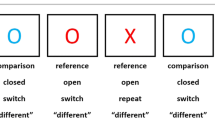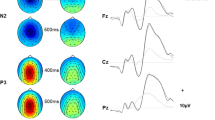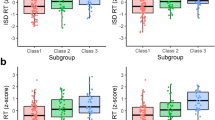Abstract
Evidence suggests that the flexibility of managing (creating and updating) stimulus–response bindings is driven by the dopaminergic system. Given that striatal dopamine (DA) plays a crucial role in the updating of working memory, the present study tested whether individual differences in the efficiency of updating stimulus–response episodes (event files) are predicted by differences in genetic predisposition related to the efficiency of the striatal dopaminergic pathway. In view of contrasting claims that stimulus–response binding is related to norepinephrine, we also considered genetic predispositions regarding noradrenergic pathways. In a sample of 100 healthy adults, we studied whether the degree to which stimulus–response bindings affect ongoing performance is predicted by polymorphisms of the dopamine transporter gene (DAT1, associated with striatal DA levels) and DBH5′-ins/del (strongly correlated with dopamine beta-hydroxylase, the enzyme catalyzing the dopamine-norepinephrine conversion). The performance of 9-repeat carriers of the DAT1 gene was more affected by stimulus–response bindings than the performance of 10/10 homozygotes was, while DBH5′-ins/del polymorphism was not related to performance. This outcome pattern suggests a crucial role of the nigrostriatal dopaminergic pathway in the flexible management of stimulus–response episodes, whereas norepinephrine does not seem to play a role.

Similar content being viewed by others
References
Abeles M (1991) Corticonics: Neural circuits of the cerebral cortex. Cambridge University Press, Cambridge
Allen RJ, Baddeley AD, Hitch GJ (2006) The binding of visual features in working memory: is integration automatic or resource demanding? J Exp Psychol Gen 135:298–313
Ashby FG, Isen AM, Turken U (1999) A neuropsychological theory of positive affect and its influence on cognition. Psychol Rev 106:529–550
Ashby FG, Valentin VV, Turken U (2002) The effects of positive affect and arousal on working memory and executive attention: Neurobiology and computational models. In: Moore S, Oaksford M (eds) Emotional cognition: From brain to behavior. John Benjamins, Amsterdam, pp 245–287
Balleine BW, O’Doherty JP (2010) Human and rodent homologies in action control: corticostriatal determinants of goal-directed and habitual action. Neuropsychopharmacol 35:48–69
Bertolino A, Blasi G, Latorre V et al (2006) Additive effects of genetic variation in dopamine regulating genes on working memory cortical activity in human brain. J Neurosci 26:3918–3922
Blin O, Masson G, Azulay JP, Fondarai J, Serratrice G (1990) Apomorphine-induced blinking and yawning in healthy volunteers. Brit J Clin Pharmaco 30:769–773
Colzato LS, Erasmus V, Hommel B (2004) Moderate alcohol consumption in humans impairs feature binding in visual perception but not across perception and action. Neurosci Lett 360:103–105
Colzato LS, Fagioli S, Erasmus V, Hommel B (2005) Caffeine, but not nicotine enhances visual feature binding. Eur J Neurosci 21:591–595
Colzato LS, Raffone A, Hommel B (2006a) What do we learn from binding features? Evidence for multilevel feature integration. J Exp Psychol HPP 32:705–716
Colzato LS, van Wouwe NC, Lavender TJ, Hommel B (2006b) Intelligence and cognitive flexibility: fluid intelligence correlates with feature “unbinding” across perception and action. Psychon Bull Rev 13:1043–1048
Colzato LS, van Wouwe NC, Hommel B (2007a) Feature binding and affect: emotional modulation of visuo-motor integration. Neuropsychologia 45:440–446
Colzato LS, van Wouwe NC, Hommel B (2007b) Spontaneous eye-blink rate predicts the strength of visuomotor binding. Neuropsychologia 45:2387–2392
Colzato LS, van den Wildenberg W, van der Does WAJ, Hommel B (2010) Genetic markers of striatal dopamine predict individual differences in dysfunctional, but not functional impulsivity. Neuroscience 170:782–788
Colzato LS, van Wouwe N, Hommel B, Zmigrod S, Ridderinkhof R, Wylie S (2012a) Dopaminergic modulation of the updating of stimulus-response episodes in Parkinson’s disease. Behav Brain Res 228:82–96
Colzato LS, Zmigrod S, Hommel B (2012b) Working memory updating predicts individual differences in updating stimulus-response episodes. Manuscript submitted for publication
Cools R (2006) Dopaminergic modulation of cognitive function—Implication for L-DOPA therapy in Parkinson’s disease. Neurosci Biobehav Rev 30:1–34
Cools R, Gibbs SE, Miyakawa A, Jagust W, D’Esposito M (2008) Working memory capacity predicts dopamine synthesis capacity in the human striatum. J Neurosci 28:1208–1212
Cubells JF, Kranzler HR, McCance-Katz E, Anderson GM, Malison RT, Price LH, Gelernter J (2000) A haplotype at the DBH locus, associated with low plasma dopamine beta-hydroxylase activity, also associates with cocaine-induced paranoia. Mol Psychiat 5:56–63
de Wit S, Barker R, Dickinson A, Cools R (2011) Habitual versus goal-directed action control in Parkinson’s disease. J Cogn Neurosci 23:1218–1229
DNA Genotek, Inc. (2006) Oragene™ product brochure. Ottawa: DNA Genotek, Inc
Engel AK, Singer W (2001) Temporal binding and the neural correlates of sensory awareness. Trends Cogn Sci 11:16–25
Floresco S, West A, Ash B, Moore H, Grace A (2003) Afferent modulation of dopamine neuron firing differentially regulates tonic and phasic dopamine transmission. Nature Neurosci 6:968–973
Grace AA (1991) Phasic versus tonic dopamine release and the modulation of dopamine system responsivity: a hypothesis for the ethiology of schizophrenia. Neuroscience 41:1–24
Grahn JA, Parkinson JA, Owen AM (2008) The cognitive functions of the caudate nucleus. Prog Neurobiol 86:141–155
Harley CW (2004) Norepinephrine and dopamine as learning signals. Neural Plast 11:191–204
Harmer CJ, McTavish SF, Clark L, Goodwin GM, Cowen PJ (2001) Tyrosine depletion attenuates dopamine function in healthy volunteers. Psychopharmacol 151:105–111
Harrison BJ, Olver JS, Norman TR, Burrows GD, Wesnes KA, Nathan PJ (2004) Selective effects of acute serotonin and catecholamine depletion on memory in healthy women. J Psychopharmacol 18:29–36
Heinz A, Goldman D, Jones D, Palmour R, Hommer D, Gorey J, Lee K, Linnoila M, Weinberger D (2000) Genotype influences in vivo dopamine transporter availability in human striatum. Neuropsychopharmacol 22:133–139
Hommel B (1998) Event files: evidence for automatic integration of stimulus response episodes. Vis Cogn 5:183–216
Hommel B (2004) Event files: feature binding in and across perception and action. Trends Cogn Sci 8:494–500
Hommel B (2005) How much attention does an event file need? J Exp Psychol HPP 31:1067–1082
Hommel B, Colzato LS (2004) Visual attention and the temporal dynamics of feature integration. Vis Cogn 11:483–521
Hommel B, Colzato LS (2009) When an object is more than a binding of its features: evidence for two mechanisms of visual feature integration. Vis Cogn 17:120–140
Hommel B, Kray J, Lindenberger U (2011) Feature integration across the lifespan: stickier stimulus-response bindings in children and older adults. Front Psychol 2:268
Jaskiw GE, Bongiovanni R (2004) Brain tyrosine depletion attenuates haloperidol-induced striatal dopamine release in vivo and augments haloperidol-induced catalepsy in rats. Psychopharmacol 172:100–107
Jensen O, Kaiser J, Lachaux JP (2007) Human gamma-frequency oscillations associated with attention and memory. Trends in Neurosci 30:317–324
Karson CN (1983) Spontaneous eye-blink rates and dopaminergic systems. Brain 106:643–653
Kleven MS, Koek W (1996) Differential effects of direct and indirect dopamine agonists on eye blink rate in cynomolgus monkeys. J Pharmacol Exp Therap 279:1211–1219
Kühn S, Keizer A, Colzato LS, Rombouts SAB, Hommel B (2011) The neural underpinnings of event-file management: evidence for stimulus-induced activation of, and competition among stimulus-response bindings. J Cogn Neurosci 23:896–904
Lecrubier Y, Sheehan DV, Weiller E, Amorim P, Bonora I, Sheehan KH (1997) The mini-international neuropsychiatric interview (M.I.N.I.): a short diagnostic structured interview: reliability and validity according to the CIDI. Eur Psychiatry 12:224–231
Lewis D, Melchitzky D, Sesack S, Whitehead R, Auh S, Sampson A (2001) Dopamine transporter immunoreactivity in monkey cerebral cortex: regional, laminar, and ultrastructural localization. J Comp Neurol Psychol 432:119–136
Li SC, Hämmerer D, Müller V, Hommel B, Lindenberger U (2009) Lifespan development of stimulus-response conflict cost: similarities and differences between maturation and senescence. Psychol Res 73:777–785
Luck SJ, Vogel EK (1997) The capacity of visual working memory for features and conjunctions. Nature 390:279–281
McDonald RJ, White NM (1993) A triple dissociation of memory systems: hippocampus, amygdala, and dorsal striatum. Behav Neurosci 107(1):3–22
Moustafa AA, Sherman SJ, Frank MJ (2008) A dopaminergic basis for working memory, learning and attentional shifting in Parkinsonism. Neuropsychologia 46:3144–3156
Nahmias J, Burley MW, Povey S, Porter C, Craig I, Wolfe J (1992) A 19 bp deletion polymorphism adjacent to a dinucleotide repeat polymorphism at the human dopamine beta-hydroxylase locus. Hum Mol Genet 1:286
Raven JC, Court JH, Raven J (1988) Manual for Raven’s progressive matrices and vocabulary scales. Lewis, London
Reading PJ, Dunnett SB, Robbins TW (1991) Dissociable roles of the ventral, medial and lateral striatum on the acquisition and performance of a complex visual stimulus-response habit. Behav Brain Res 45:147–161
Rodriguez-Bermudez R, Kallenbach U, Singer W, Munk MH (2004) Short- and long-term effects of cholinergic modulation on gamma oscillations and response synchronization in the visual cortex. J Neurosci 24:10369–10378
Sax KW, Strakowski SM (1998) Enhanced behavioral response to repeated d-amphetamine and personality traits in humans. Biol Psychiat 44:1192–1195
Sesack SR, Hawrylak VA, Matus C, Guido MA, Levey A (1998) Dopamine axon varicosities in the prelimbic division of the rat prefrontal cortex exhibit sparse immunoreactivity for the dopamine transporter. J Neurosci 18:2697–2708
Shumay E, Chen J, Fowler JS, Volkow ND (2011) Genotype and ancestry modulate brain’s DAT availability in healthy humans. PLoS One 6:e22754
Siessmeier T, Kienast T, Wrase J, Larsen JL, Braus DF, Smolka MN et al (2006) Net influx of plasma 6-[18F]fluoro-l-DOPA (FDOPA) to the ventral striatum correlates with prefrontal processing of affective stimuli. Eur J Neurosci 24:305–313
Taylor JR, Elsworth JD, Lawrence MS, Sladek JR, Roth RH, Redmond DE (1999) Spontaneous blink rates correlate with dopamine levels in the caudate nucleus of MPTP-treated monkeys. Exp Neurol 158:214–220
van Dam WO, Hommel B (2010) How object-specific are object files? Evidence for integration by location. J Exp Psychol HPP 36:1184–1192
van de Giessen E, de Win MM, Tanck MW, van den Brink W, Baas F, Booij J (2009) Striatal dopamine transporter availability associated with polymorphisms in the dopamine transporter gene SLC6A3. J Nucl Med 50:45–52
Verguts T, Notebaert W (2009) Adaptation by binding: a learning account of cognitive control. Trends Cogn Sci 13:252–257
Waldman ID, Rowe DC, Abrinteamowitz S, Kozel T, Mohr JH, Sherman L et al (1998) Association and linkage of the dopamine transporter gene and attention-deficit hyperactivity disorder in children: heterogeneity owing to diagnostic subtype and severity. Am J Hum Genet 63:1767–1776
Yin H, Knowlton B, Balleine B (2004) Lesion of dorsolateral striatum preserve outcome expectancy but disrupt habit formation in instrumental learning. Eur J Neurosci 19:181–189
Acknowledgments
We thank Sabine Maaskant, Willem Turnhout, Raoul Putman, Alain Boersen, Marieke van der Meer, and Linda van Hooidonk for their enthusiasm and invaluable assistance in recruiting, testing the participants of this study and collecting the data.
Author information
Authors and Affiliations
Corresponding author
Rights and permissions
About this article
Cite this article
Colzato, L.S., Zmigrod, S. & Hommel, B. Dopamine, norepinephrine, and the management of sensorimotor bindings: individual differences in updating of stimulus–response episodes are predicted by DAT1, but not DBH5′-ins/del. Exp Brain Res 228, 213–220 (2013). https://doi.org/10.1007/s00221-013-3553-x
Received:
Accepted:
Published:
Issue Date:
DOI: https://doi.org/10.1007/s00221-013-3553-x




